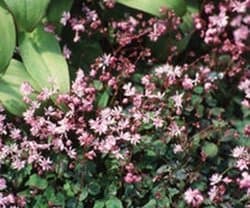
Meadow-rues (Thalictrum species and cultivars) have long been a favourite in my mostly part-shade garden, both the highly ornamental border plants as well as two dwarf species. The two low-growing meadow-rues are subtle plants, but have their own charms and make ideal groundcovers.
I confess to being the kind of gardener who makes collections, and one spring I bought samples of every meadow-rue I could find. Among them was T. minus ‘Adiantifolium’ (Zone 4), sometimes called lesser meadow-rue. The cultivar name, ‘Adiantifolium’, is a nod to maidenhair fern, Adiantum pedatum, which has similar foliage. This clump-forming meadow-rue is shorter than its high-class cousins, growing 24 inches (60 cm) tall and 18 inches (45 cm) wide, with small ferny foliage and sprays of tiny greenish-white flowers in late spring. Although lacking the ornamental appeal of larger meadow-rue cultivars, it makes a lacy groundcover when planted in part shade or dappled light. (T. minus will accept full sun if the soil is kept wet and never allowed to dry out.)
This is the kind of plant that can be useful filling space in a humusy woodland border or under small trees like Japanese maple and redbud. The flower sprays are small and delicate, and show best when several plants are massed together. To get the best effect, start with five to seven plants, and the group will increase slowly by creeping rhizomes. Even when the flowers are finished, the foliage is beautiful all summer, and stays if the soil is consistently moist.
Even shorter is dwarf meadow-rue (T. kiusianum, Zone 5), a mat-forming, creeping thalictrum that grows four inches (10 cm) tall and 12 inches (30 cm) wide. This miniature meadow-rue will make a mound of deep green leaves with attractive lilac-mauve flowers in summer, producing short rhizomes that spread slowly. T. kiusianum likes a moist, peaty soil, and is comfortable in woodland conditions, or even in a trough garden. It’s a good plant for adding detail to small areas, and several plants could be clustered at the corner of a border around an interesting rock.









Thanks for the article on Thalictrums! I have 2. Thaictrum Delavayi “Anne” However, it is about 6-7′ tall! It is in bloom now (July) I just love this plant for it’s delicate airiness. The other one is Thalictrum aquilegifolium “Puepureum which is a much shorter plant and bloomed in June.
I am going to read Patrick Lima’s article so that I can find more of these beautiful, easy to grow plants.
My soil is sandy which I amend each year with my own home grown compost. and live in Zone 6a.
Maggie Low-Keen